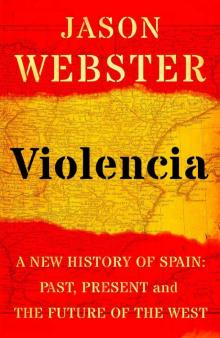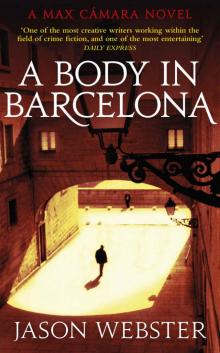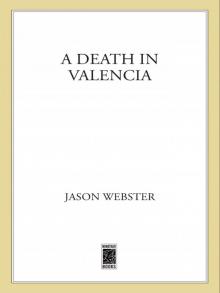- Home
- Jason Webster
Violencia Page 2
Violencia Read online
Page 2
Yet Spain is currently going through moments of great stress, and these are intrinsically bound up with patterns and structures which have governed events in the country for well over a thousand years: moments of brightness, of openness and experimentation in her past regularly give way to insularity, self-obsession and darkness. In that way she is a prisoner of her own history. Unless she can come to a swift and better position of self-awareness, she appears destined to follow one of two paths into the future. Neither will be pleasant; both involve bloodshed.
And why that matters is because what happens in Spain today and tomorrow will predict in large part what takes place elsewhere the day after.
1 Beyond Spain, it is frequently overlooked that in her African exclaves of Ceuta and Melilla, there are actual land borders between the developed and developing worlds.
THE THREE FACES OF ST JAMES
St James – Santiago – patron saint of Spain, icon and symbol of a country. The man who, officially, lies buried at Compostela in the north-western corner of the Iberian Peninsula, final destination of the most important pilgrimage in Christendom1: Christianity’s ‘Mecca’.
As with many saints, James’s story is complicated. Yet where other national patrons may be easily identified – St George with his dragon, St Andrew with his X-shaped cross, or St Patrick with his snakes – Santiago comes in very different guises, ones which in ordinary circumstances would be mutually exclusive.
In fact, pilgrims crossing the Pyrenees might be forgiven for wondering who St James really is, not because the source material about him dates from remote times, but because he has what today could be termed ‘branding issues’. There isn’t a single, clearly recognised image of the man. Instead there are three.
Let’s take the first. This shows James as an Apostle of Christ. He is not just any Apostle: James is one of the three closest disciples of Jesus, along with John (James’s younger brother and author of the Gospel that bears his name) and Peter. These men are the only ones who witness the Transfiguration. A fisherman by trade and son of Zebedee, this is James the Greater, so called to distinguish him from another Apostle of the same name, James the Less. (The original Ya’akov became Iacobus in Latin, which eventually turned into the English James. In Spain it evolved into both ‘Jaime’ and ‘Iago’. ‘Sant Iago’ was elided into ‘Santiago’, which then went on to become Diego, or Tiago in Portuguese.)
St James the Greater was a hothead. Luke’s Gospel mentions how, when Jesus and his disciples were turned away from a Samaritan town, James and John suggested burning the place to the ground in a scorched-earth reprisal. Similar, eyebrow-raising behaviour appears in an anecdote related in Mark’s Gospel, when James and John ask to sit at Jesus’s right and left side ‘in glory’. On both occasions they are rebuked, and receive the nickname ‘Boanerges’, the ‘sons of thunder’ in reference to their fiery nature.
Be that as it may, James’s status as a senior disciple was confirmed by his being the only Apostle whose martyrdom is mentioned in the New Testament: he was put to the sword in AD 44 by the order of King Herod Agrippa, friend of the Emperor Claudius.
What happened next introduces the Spanish connection. Stories linking St James to the Iberian Peninsula began to appear around the early seventh century. According to these sources, after his death James’s friends placed his body in a boat made of stone which had neither sails, oars nor sailors. The boat then made its own miraculous way along the Mediterranean, through the Strait of Gibraltar, and up the western Iberian coast till it landed in Galicia at a place called Iria Flavia2. After a number of adventures, the body was finally buried, only to be discovered – again, miraculously – several hundred years later in the ninth century, an event which initiated the famous pilgrimage in his name.
The reason why, according to the stories, James’s body found its way to Spain is because in the years before his death he had already visited the Peninsula. Again, the legends developed centuries afterwards, but following the ‘speaking in tongues’ at Pentecost, the Apostles dispersed to preach Jesus’s message. James got the task of converting the Diaspora Jews. By the seventh century, in an anonymous text known as the Breviarium Apostolorum, this mission had been specified to ‘Spain and the West’. It was shortly after his return to Judea from Spain that James was executed.
We shall return to the legends of St James in more detail when we reach the Middle Ages and the establishment of the pilgrimage to Compostela. For the time being, consider this pattern, for it will crop up again several times: a man very close to a prophet or a deity travels from the East to perform great deeds in Spain; thanks to his efforts, a new culture develops, and a new connection between Spain and the rest of the world is established.
Now, given his importance as a disciple, you would assume that images of St James would draw inspiration from the New Testament. It’s true that as you progress along the pilgrimage route – or travel throughout Spain – paintings or sculptures of him with a beard and biblical-looking robes can be found. But not very often, or at least not as often as you might think.
For St James has two other manifestations.
The second is that of Santiago as a pilgrim, dressed as a typical medieval foot-traveller with long robes, a staff, a leather satchel over his shoulder, and a wide-brimmed hat with a scallop shell – symbol of the pilgrimage – attached to the front. There is, of course, no mention of him dressing or acting in this manner in the Bible, but in this guise he acts as a kind of mirror, reflecting the pilgrim back to himself. He is a seeker, a man alone in the world, on a quest, in search of answers, a distant and sacred destination in mind. He is open and friendly, at the mercy of whatever Life or Fate may send his way. He is gentle and harmless, barely leaving an imprint on the world he is passing through, his mind focused on the next world, on the world beyond worlds. He is a mystic, a person for whom this life represents a mere moment, a passage, a journey through illusion.
This Santiago is a traveller and a man of peace. He seeks answers and wishes to cure ills.
What greater contrast, then, could there be with the third and final manifestation of Spain’s patron saint?
This is St James as he is commonly seen in every corner of the country. The apostolic robes have been exchanged for armour, the pilgrim’s staff for a sword. And the saint no longer walks, he rides a white horse. Most importantly, preaching a message of turning the other cheek has been replaced by the more vigorous activity of slaughtering the enemy. And in case you’re wondering who the saint is violently despatching to the other side, observe the turbans on their severed heads.
This is Santiago ‘Matamoros’, the ‘Moor-Slayer’, symbol of military might, the soldier, the victor, the oppressor, the killer. A bloodstained hero who crashes in and smites whoever needs to be smitten in the name of Spain, its purity, its unity, its very being. He is the sword and shield of the country, its creator and defender, the man in whose name it exists and continues to exist. No mercy, no discussion, no subtlety. Mere might and righteousness, and a simple answer: the use of extreme violence to oppress and exterminate the enemy, the Other.
One saint, three very different images: the Saint, the Seeker and the Slayer.
It is common when referring to Spain and Spanish history to talk about las dos Españas in reference to a poem by twentieth-century poet Antonio Machado coining the phrase.3 Two versions of the country, according to the idea, are perpetually at loggerheads, trying to annihilate each other. Yet this is only a partial truth. As the manifestations of Santiago, Spain’s patron and symbol, indicate, there are in fact three Spains, two in direct opposition, while the third watches from the sidelines, generally patiently but sometimes wearily, trying to explain to the other two the folly of their struggle.
This is Spain.
And these are her three faces.
1 Dixit Dante.
2 Today’s Padrón, home of Spain’s occasionally spicy chilli peppers ‘Pimientos de Padrón’. Whether there is a conne
ction here with St James’s alleged hotheadedness is not known.
3 Epañolito que vienes / al mundo, te guarde Dios. / Una de las dos Españas / ha de helarte el corazón. ‘Oh little Spaniard, fresh in the world, may God protect you. For one of the two Spains will chill your heart.’
PART ONE
PRE-SPAIN
GEOGRAPHY
Geography can give clues to much of a country’s national character and behaviour, even determine it. This holds no less for Spain, whose location and landscape explain some of her essential paradoxes: her simultaneously open and yet closed, almost bunker-like tendencies; her singular coherence and perpetual regional struggles; her strong sense of self coexisting with constant debate over her own identity.
Geographically, Spain is a series of castles within a greater castle
Like Britain, Spain is at once part of and yet semi-detached from Europe. But while the sea marks Britain’s divide from the Continent, Spain is at one remove thanks to the high mountains of the Pyrenees. These were formed from the Cretaceous Period to the Eocene Epoch as the Iberian Plate, a tectonic land mass in its own right, rotated anticlockwise and smashed into southern France. In a similar fashion to India, whose movement northwards has caused the rising of the Himalayas, Spain is akin to a subcontinent, if on a much smaller scale.
This geological separateness reflects both a certain uniqueness about Spain and its enormous internal complexity.
Mountains are a key feature of the Spanish landscape. A surprising fact, perhaps, when the vast, flat, and quintessentially Spanish plains of the interior are conjured in the imagination. Yet much of these areas, despite their relative lack of high peaks, lie at well over 600 metres, or 2,000 feet – the generally accepted minimum height for a mountain. In fact the average height of the whole country is 660 metres, making it the second-most mountainous country in Europe after Switzerland, with an average altitude of 1,350 metres. Compare this to France (375 metres), Germany (263 metres) and low-lying Britain (162 metres) and you get a sense of quite how high up much of Spain really is. As much as a quarter of the country has an altitude of over 1,000 metres, with only about 10 per cent lying at less than 200 metres above sea level.
The central Meseta, or Tableland, apart, what’s curious about these mountains is that many of them lie along or close to the coasts. If the Pyrenees form a barrier with France, then similar mountain chains rise up steeply from the sea along almost every Spanish shoreline: the Cantabrian Cordillera along the north, the Iberian System in the east, and the Betic System in the south. Where any strip between sea and mountains exists at all, it is usually quite narrow. Geographically, Spain appears like a fortress or castle, with high walls defending its outer perimeter.
Yet contrast this with its location, and the first paradox becomes apparent. Spain is nothing if not a crossing point: it touches Europe to the north and is only eight miles away from Africa at its southern tip; half of its coastline is Mediterranean, the other Atlantic – passage from one body of water to the other can only take place by skirting the Spanish shoreline. Not surprising, then, that it was the springboard for the Old World’s discovery of the New. And also why it has been settled throughout history by peoples from all quarters, from Germanic tribes to Berbers and from Jews to Celts.
But this openness and expansiveness comes hand in hand with a tendency towards isolationism. For the walls that constitute the coastline mountain ranges are not alone: further ranges stretch inland, dividing this subcontinent into natural zones, with widely varying climates. Andalusia, for example, has its own dividing line from the rest of the country in the shape of the Sierra Morena, rising from the northern banks of the River Guadalquivir. So emblematic is the only pass through this range – the Despeñaperros gorge – that it is used in much the same way as the English talk of the Watford Gap to denote a geographical marker between north and south.
Castilla–León, the heartland of old, Catholic Spain and birthplace of El Cid, is walled in both to the south by the Sierra de Guadarrama, which divides it from Madrid, and the Cantabrian chain to the north cutting it off from the sea. Castilla–La Mancha contains such a richness of natural barriers that until the past thirty years there were no direct transport communications between Madrid and its nearest port city (as the crow flies), Valencia. Only recent developments in civil engineering have allowed Man finally to conquer it, several decades after landing on the Moon . . .
The various rivers cutting through these mountain ranges offer only small chinks in the defensive walls: both the Ebro and the Tagus become unnavigable a short way inland as they bend and twist their way past towering rock faces. The Guadalquivir is the only exception, and allowed the Moors to establish their capital deep in the Andalusian heartland at Cordoba. But silting problems made this passage short-lived: any modern visitor to the city struggles to imagine today’s shallow waters once constituting one of the most important shipping lanes in the world.
Historically speaking, travel and communication across the Peninsula have been, if not impossible, then complicated. Which brings us to the second paradox: geologically and geographically, Spain has a clear, unified sense of self (pace Portugal). Seen from outer space, it is one of the world’s more easily identifiable countries, its boundaries clearly visible in the shape of coastlines, or the Pyrenees mountains. And yet this unity fails to provide cohesion within the country itself because those same mountain barriers also form internal divisions which historically have delineated the various segments which make up the country. Standing on the edge of a green Galician fjord-like Ría with grey, melancholy Atlantic winds blowing in, you feel far closer in spirit to Ireland or Brittany than to the toehold of the Sahara Desert which has leapt the Mediterranean and established itself on the opposite corner of the Peninsula at Almería. Likewise at Tarifa, Spain’s most southerly tip, where Africa is so close you feel you could reach out and touch it, your imagination struggles to grasp that you are in the same country as the temperate ash and oak forests of northern Navarre.
Such geographical differences heighten and strengthen the many regional identities within Spain. Seen from one level, a micro-level, they are distinct nations. Yet from a macro-level they are obviously one. Both views are correct; at one time or another, either one or the other has prevailed, and the perpetual question that hangs over Spain and its identity has been the cause of much violence and bloodshed.
PEOPLES
Few countries in the Old World enjoy Spain’s rich mixture of cultures. For many thousands of years, peoples have travelled to the Iberian Peninsula from all directions. And while the country has been the final destination for many of these migrations, it has also – in a tradition that continues to this day – acted as the launch pad for large exoduses, some voluntary, others forced.
Something of this pattern emerges from very early human times, when the Peninsula became the last bastion of the much-maligned (although increasingly respected) Neanderthals. It was at the southern tip of Spain, the Rock of Gibraltar, that the last of their kind are thought to have holed up, a small, final group of a hominid that had once roamed the European Continent. Pushed out by their smaller but presumably more capable Cro-Magnon cousins (with an occasional inter-species sexual encounter en route), they lived in caves, unable to escape across the Strait to possible safety on the other side. Had they done so, perhaps the history of humanity would have been quite different.
Millennia later, these last remaining Neanderthals provided the first evidence to modern scientists of their existence. The joke goes that ‘Neanderthal Man’ should really be called ‘Gibraltarian Woman’. In 1846, Lieutenant Edmund Flint of the Royal Navy was involved in excavations for the construction of a new fortification at the northern end of the Rock. Stone for the structure came from nearby Forbes’ Quarry, and it was there that one day Flint came across what appeared to be an ancient human skull. As well as a naval officer, he was also secretary of the Gibraltar Scientific Society, and two years later, in
1848, he presented the skull to the learned members, describing it as an ancient human who had died ‘before the Flood’.
Not much more was thought of the skull, and it was left for several years in a cupboard in the Garrison Library.
In late 1859, Darwin published On the Origin of Species and a new interest in ancient bones and relics was kindled. In 1862, a couple of palaeontologists visiting Gibraltar, George Busk and Hugh Falconer, examined the skull, and two years later they presented a report on it to the British Association for the Advancement of Science in London, concluding, as Darwin himself did after examining it, that it belonged to an extinct human species and should be named Homo Calpicus, after the ancient Greek name for Gibraltar, ‘Calpe’.
Only later did Busk realise that it was the same species as the one discovered a few years earlier, in 1856, in the Neander valley near Dusseldorf. The Gibraltarian female skull was in fact Homo Neanderthalis.
If the Strait served as a barrier for the Neanderthals, however, it acted as a bridge for later cultures. The Neolithic period begins in Spain with the arrival of farmers from North Africa some seven thousand years ago. Genetic studies suggest they had originated in the Fertile Crescent and made their way down into Arabia before crossing the Horn of Africa into today’s Sudan, pushing up through Egypt and from there westwards to the Maghreb. On reaching Spain, they seem to have limited their presence to the southern and eastern coasts, leaving the hunter-gatherers further inland to their own devices. These new arrivals brought crop-growing techniques with them, living off cereals and legumes, as well as pork and rabbit and, that most typical of Mediterranean foods, olives.

 Violencia
Violencia Or the Bull Kills You
Or the Bull Kills You The Killing of El Niño Jesús
The Killing of El Niño Jesús The Spy with 29 Names
The Spy with 29 Names Duende
Duende Guerra
Guerra Sacred Sierra
Sacred Sierra A Body in Barcelona: Max Cámara 5
A Body in Barcelona: Max Cámara 5 Fatal Sunset
Fatal Sunset A Death in Valencia
A Death in Valencia Blood Med
Blood Med Andalus
Andalus